Article
Ojai Valley Part II: The Artists, Educators and Spiritual Thinkers
Author(s):
Those who have come to make their home the Ojai Valley fall into three broad types: the artists, the educators and the spiritual thinkers. Although sometimes it's hard to separate the artists from the spiritual thinkers.
Those who have come to make their home the Ojai Valley share some of the Chumash Native American values. They fall into three broad types, says town historian Cricket Twichell: the artists, the educators and the spiritual thinkers.
The artists
It may not be possible to separate the artists from the spiritual thinkers when you meet them and try to discover their soul. Sandy Wolk, for example, in the pottery studio she shares with Larry Carnes and Greg Bressani, describes herself as “artist, healer, visionary.”
“Art becomes for us a vehicle for healing … and a means by which we come home to ourselves,” she says.
Her sculptures suggest that home for her is her affection for animals and children. Her favorite themes range from Love Between Woman and Horse to Mother and Child. The sculpture illustrated is called Held in the Hand of Life.
Fellow potter Larry Carnes feels he understands the Chumash, too.
“My philosophy of life is derived from that of the Native American,” he says. “Respect and appreciation of the world around me: people, animals, plants and earth.”
He stands holding one of the sacred Chumash stones he has made showing the symbols created by their Shaman ancestors.
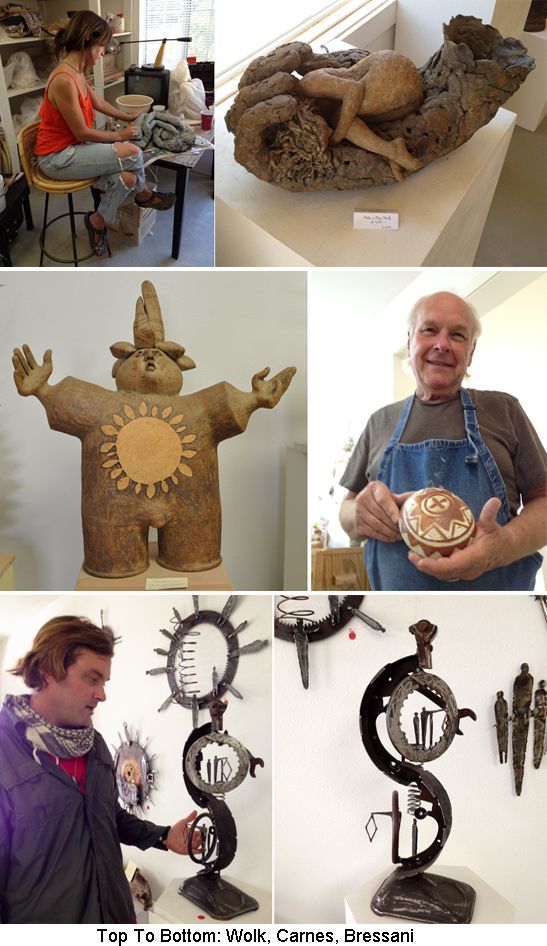
Carnes speaks highly of the First People.
“There wasn’t a Native American in California who ever went hungry!” he says, surely a tribute to any tribe’s culture. We look at his figure of a Chumash shaman, hands uplifted to the Sun, his God.
“Most shamans were physicians also,” he adds. “They interpreted the stars and said when the seasons’ solstices would occur. Most were small in stature, odd and many gay. Their training as doctors was by word of mouth and trial and error.”
“A bit like medical school today!” grins a nurse listening to the conversation.
Greg Bressani, his friend, designs multidimensional art. He was a forest ranger in Sedona, Ariz. for eight years “attuned to nature and its sounds.” With his friend Steven Red Hawk he recorded a CD playing their Native American flutes against those sounds — from humming birds hovering on a mountain top to waves crashing on a beach. He recycles old farm machinery, automobile parts and other metal parts found at random during his travels. He’s also a laid-back guide with the Cliff Climbers jeep tours mentioned in the first Ojai article. His blog shows absorbing examples of his work.
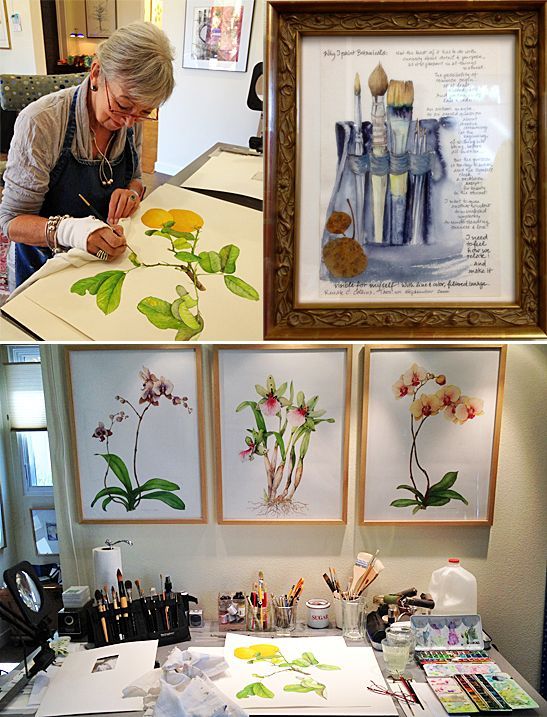
Botanicals have their own rules lest they become simple still lives. Botanical art does not show shadows. The apparent bandage on Renate’s right wrist is not for medical reasons but to prevent skin oils from her wrist touching her paper.
Artists are complicated persons. They see things we don’t — but wish we could. They can appear to be gentle, sensitive, engaging souls, but sometimes they reveal themselves as more grounded than the rest of us. They seem to know who they are and where they’re going as if they have a destiny or a story to tell in their art and they’re well on their way.
Welcome to Renate (Collins) Hume. Born in Münster, Westphalia, Germany, and trained as a pharmacist you’d expect her to be meticulous, and she is, but she came to her art — the painting of botanicals — in an indirect way. Her husband, also a pharmacist, was a mountaineer who died in a fall off a mountain. Renate changed careers and became a psychotherapist, training at the Jung Institute in Switzerland, her specialty was dream psychology. We feel safe talking to Renate; one of us doesn’t remember dreams and the other won’t talk about them.
Renate and her daughter decided to take art classes at the New York Botanical Gardens. The subject that night was a daffodil. They came out of class at 10 p.m., the mother saying, “What an experience! What fun!” until she saw her daughter’s face and realized her evening’s pleasure was not shared. She continued on her own, nevertheless, and got a degree as a Natural Science Illustrator.
Renate also makes very expensive jewelry but she paints mostly for her own pleasure. She was encouraged to put the first 23 paintings she’d done in a show. She sold 18! Now she can’t let her work go like that.
“I can’t sell it right away,” she says. “I have to live with a piece first.”
Did she enjoy discovering art?
“I’d start after my first espresso in the morning and then suddenly it would be dark!” she answers with a smile.
Renate has painted botanicals on request from a dermatologist who wanted the pictures on the daughter’s bedroom wall. What a treasure she’d be for someone wanting to make a Holiday gift to a cardiologist, say, a painting of a Digitalis purpurea, William Withering’s foxglove. Or maybe a birthday present for an elderly internist who remembers when all we had to treat hypertension was phenobarbital till briefly we turned to Raudixin, Asia’s gift from Rawolfia serpentina.
The educators and the spiritual thinkers
They are all around you in Ojai. Boarding schools are not common on the West Coast. While there are only 11 in California, five are in Ojai, with the most prominent the being Thacher School. The school was founded in 1889 when Sherman Day Thacher, the son of a Yale professor with a horse ranch in Ojai, agreed to look after and tutor his sickly younger brother and prepare him for Yale.
Other families wanting their boy to be better prepared for Ivy League universities started sending Sherman their sons too. Girls were admitted in 1977. Currently a faculty of 48 teaches 230 students in this special school on 425 acres.
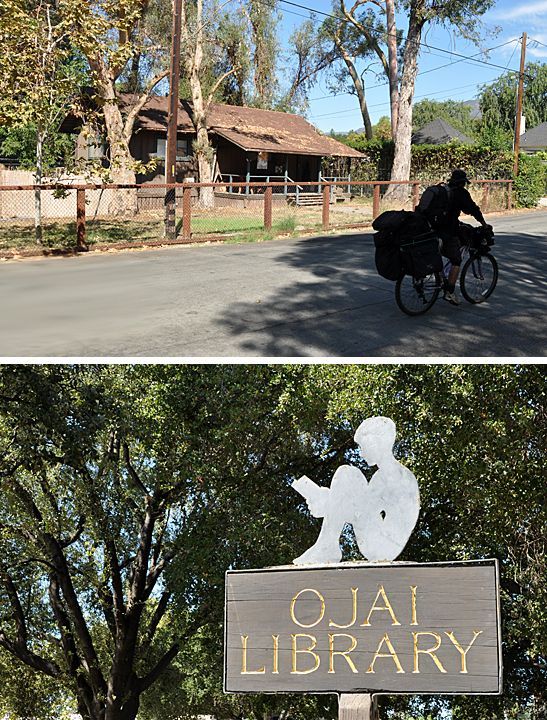
A cyclist trundles past the George Thacher Memorial Library, esablished in memory of Sherman's little brother, George, who died.
Sherman’s passion was the horse, and every pupil had to have and care for one. He used to say there’s “something about the outside of a horse that’s good for the inside of a boy.” He felt the trails and mountains were part of his classrooms too. As the town grew Ojai decided to move the town library from its downtown location to a larger site.
“But,” says Cricket, “This town is full of retired people who know how to push the right buttons! We love issues! Our library has stayed conveniently downtown.”
The museum is conveniently situated downtown also just across the street from the library. Part of the museum are three of George Stuart’s depictions of the American Indian including the magnificent Plains Indian figure called Lakota Warrior, described as one-quarter life sized and correct to the smallest detail.
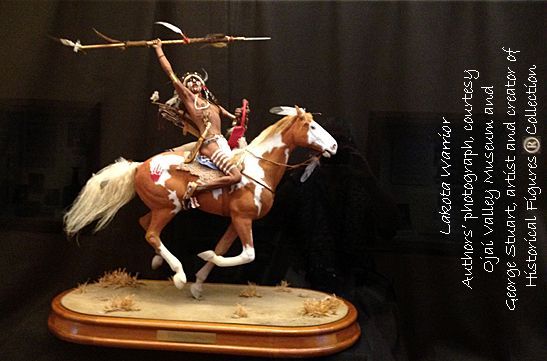
Stuart makes them on an articulated skeleton, sprays the skin on with polymers, creates the hair and scalp from Icelandic sheepskin and hand-makes the clothing and jewelry. The spiritual thinkers can stand and study and meditate.
“Yes we have spiritual thinkers here in Ojai; not just traditional but other religions too, more than you can shake a stick at!” says Cricket. “You can drive up to Krotona, the headquarters of the theosophist movement where they have the second largest library of the occult in the world (the largest being the Vatican).”
The gardeners
What about those who say they are closest to God in their garden? You find them perhaps in the wineries and olive groves.
Greg’s “All Around Ojai” tour with Cloud Climbers takes us past magnificent stone walls to the Old Creek Ranch Winery and its winemaker Michael Meagher. The winery, 850 acres of the original Spanish land grant, was bought by Carmel Maitland and her husband, Mike, in 1976. She survived him but died in 1998 at age 74. Her obituary declared she understood winemaking because “her grandmother was an Italian immigrant who squeezed her own red wine in the basement of her Detroit home!”
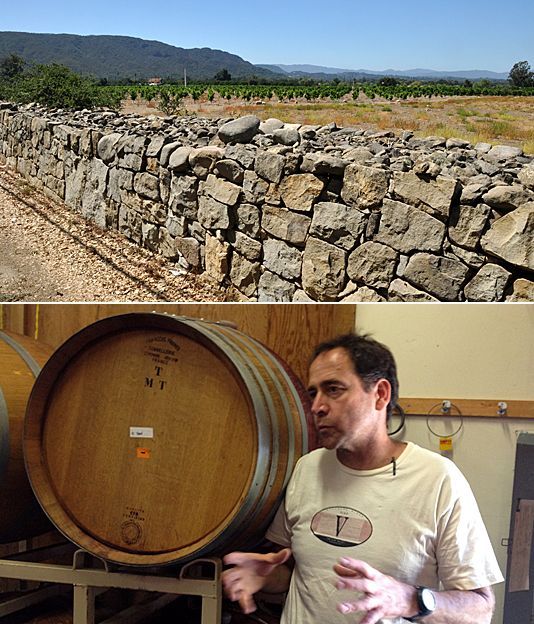
Michael Meagher now makes wine under the Old Creek Ranch label and his own Vino V label.
Carmel’s daughter and her husband Mike Mainland, the one-time president of Warners Brothers Records, now run this winery the family inherited from Carmel. It has recovered from the blight of Pierce’s disease that ravaged its vines and wiped them out by 2001. It now gets its grapes from outside vineyards.
Michael Meagher came aboard in 2007 with an Oenology degree from U.C. Davis. Asked if he misses not growing his own grapes he says, “Actually it’s nice to be able to cherry pick locations.”
The way to recognize a good winemaker, according to Michael, is to see what university he got his degree, what he’s done and with whom he’s worked. And what does it take to be a good winemaker?
“Innate ability. Natural skills. A good nose and…” he laughs and says, “It helps if, like me, he’s Irish!”
Another who loves what the land provides is Alice Asquith, who despite the post herpetic neuralgia that is always present and dominates her life, continues to educate visitors who come to learn about olive oil
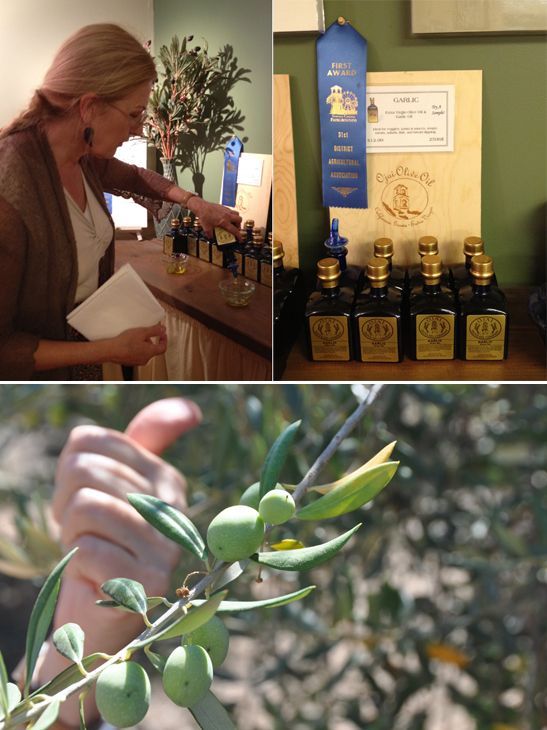
Alice and Ron Asquith bought 10 acres of Ojai orange grove in 1882 and have been growing olives there since 1998. They have a canyon that runs for 36 acres and now have 4,000 trees with another 800 coming.
Olive trees are not native, but the missionaries knew olive oil would be an easier product to produce in the heat of California than butter. And, in addition, the waste product mash could be used as oil for lamps. The Asquiths’ Ojai Olive Oil Company has won many awards, as well as many visitor plaudits from Yelp.
The Andersons, who live in San Diego, are the resident travel & cruise columnists for Physician's Money Digest/Lifestyle. Nancy is a former nursing educator, Eric a retired MD. The one-time president of the NH Academy of Family Practice, Eric is a member of the Motor Press Guild and the only physician in the Society of American Travel Writers. He has written five books, the last called The Man Who Cried Orange: Stories from a Doctor's Life.




